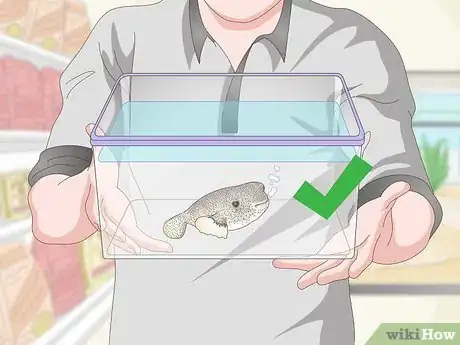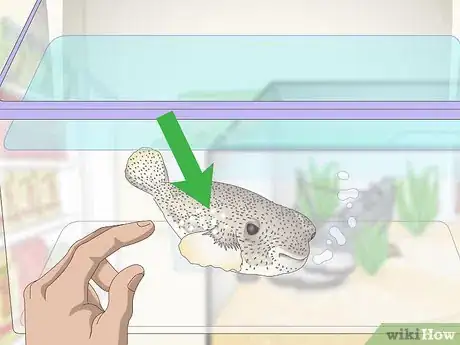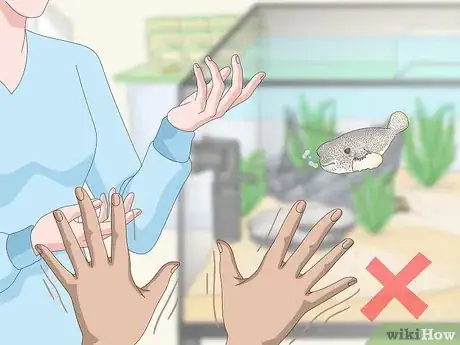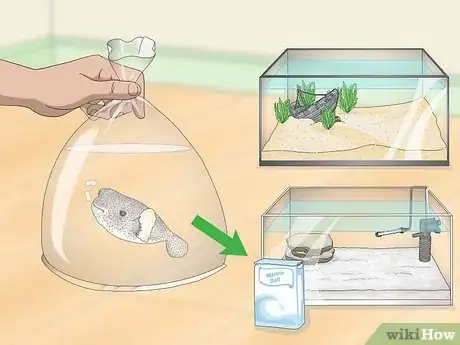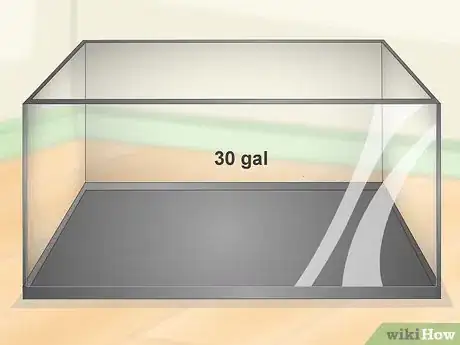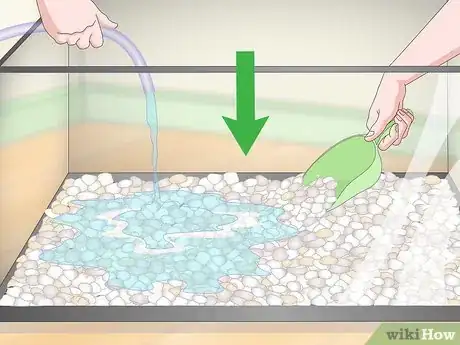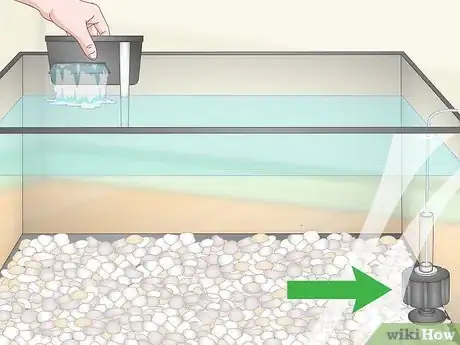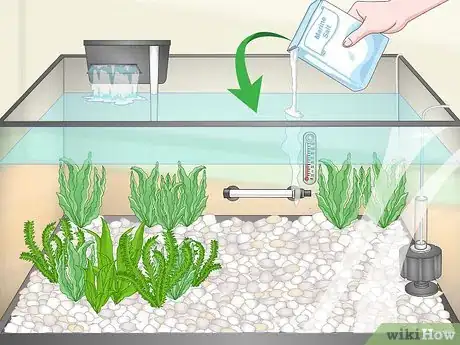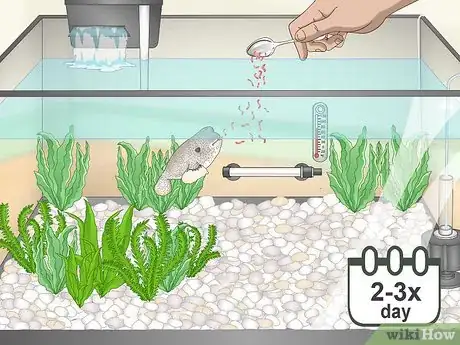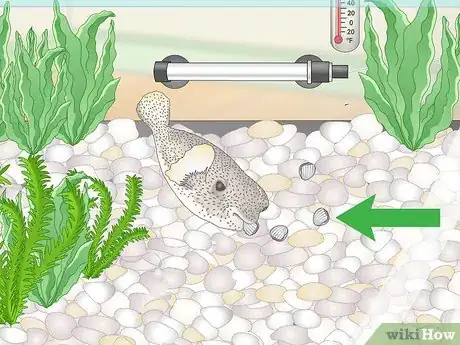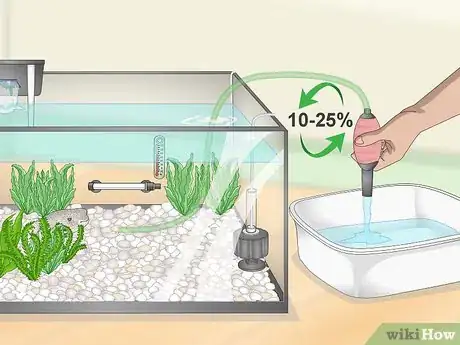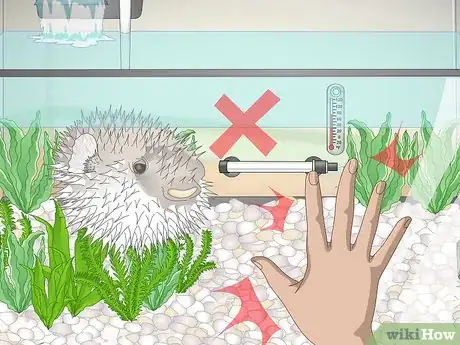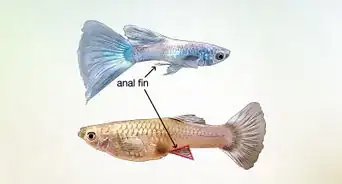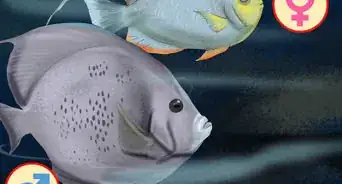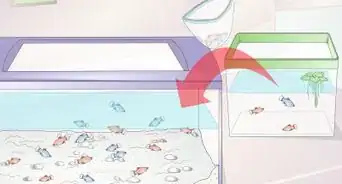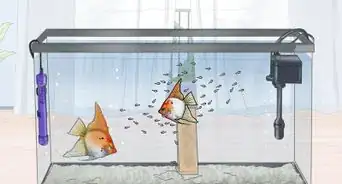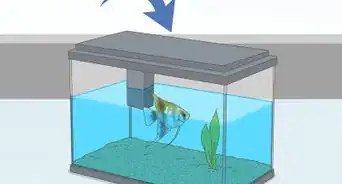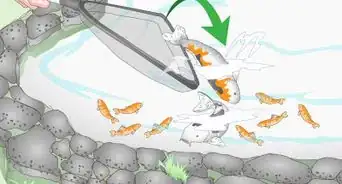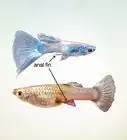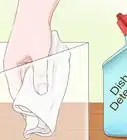This article was co-authored by Craig Morton. Craig Morton is the CEO of Aquarium Doctor Inc. based in Huntington Beach California and servicing Orange County, Los Angeles County, and the Inland Empire. With over 30 years of aquarium experience, Craig specializes in creating custom aquarium designs along with aquarium installation, service, and maintenance.
wikiHow marks an article as reader-approved once it receives enough positive feedback. In this case, 90% of readers who voted found the article helpful, earning it our reader-approved status.
This article has been viewed 47,731 times.
Puffer fish are adorable creatures with a comical, chubby appearance, known for their interesting self-defense mechanism in which they puff themselves up to look bigger. However, if you’ve never had one before, you may not know exactly how to care for a puffer fish. In order to avoid hurting your new pet, you need to make sure you give it a proper habitat, feed it a healthy diet, and keep an eye on its overall health.
Steps
Purchasing a Puffer Fish
-
1Buy your puffer fish from a reputable pet store. Avoid shopping for your puffer at a store with lots of dead fish floating in the tanks or with staff who don’t know much about keeping fish. Ask staff members specific questions about puffer fish to gauge whether you’re buying a puffer from a good store.[1]
- For example, ask a staff member what sort of food puffers like to eat. If they don’t know, or they say to just feed it fish flakes, you may want to shop at a different pet store.
- Most stores sell puffer fish for $20 to $60. If a store offers puffers at a lower price than this, this is also a possible sign that the store isn’t a reputable one.
-
2Check for signs of ick before buying a puffer fish. Ick, also known as saltwater fish disease or white spot disease, is a very common fish disease that puffers are very susceptible to. Look for the telltale white spots on the puffer’s fins before purchasing to make sure you don’t buy a puffer fish with ick.
- Ick can present a variety of symptoms, ranging from benign spots to lethargy, loss of appetite, and even death.
- Note that ick is usually treatable, so don’t worry if your puffer develops it after you buy it. However, because it can be caused or exacerbated by stress, avoid buying and transporting a puffer with ick into a new aquarium.
Advertisement -
3Refrain from buying a puffer if you don’t have experiencing owning fish. Taking care of a puffer fish is a bit more time-consuming and more complex than caring for an ordinary pet fish. As well, it may also be a relatively expensive pet to keep, so you may need to adjust your budget if you’re serious about keeping a puffer.[2]
- In contrast to more common pet fish, puffer fish require very good water quality, a lot of aquarium space, and a good diet. They’re definitely not starter pets.
- You’ll need to remain with your puffer fish often, as it requires feeding once a day, and possibly more if it is kept around other fish. This means that if you were to go on a holiday, you would need to find a person to care for your pet.
-
4Choose a species based on the type of water in your aquarium. There are many different types of puffer fish, ranging from minuscule dwarf puffers to much larger species, and they all live in different types of water. If you plan to keep saltwater or brackish water in your tank, opt for a species that lives in this type of water. Otherwise, go with a freshwater species.[3]
- The reason this choice is so important is that if you choose a saltwater or brackish water puffer fish, you’ll have to make sure the salinity level of the water in your tank remains constant.
- Note that a bigger puffer requires a bigger tank, so, just like other fish, it is necessary to find a tank that's appropriate for your puffer.
- Puffer fish are usually pretty aggressive and so they shouldn’t be kept with any tank-mates.
Setting up a Habitat
-
1Opt for at least a 30 US gal (110 L) tank to house your puffer fish. The larger your species of puffer fish, the more space it will require. If you plan on keeping more than 1 puffer fish in your tank, add at least 20 gallons (76 L) to the tank’s size for each puffer you intend to house in it.
- Puffer fish are very territorial creatures, so having a lot of space in the tank is very important for minimizing any fighting between your fish.
- Some of the larger species of puffer fish require a great deal of space. For example, puffer fish that grow to be 12 inches (30 cm) long need at least 100 gallons (380 L) of volume in their tank.
- Check with your local pet shop to see what type of tank you need for each species of puffer.
-
2Pour substrate and water into the tank. Place about 1 inch (2.5 cm) of gravel in the bottom of the tank before pouring in the water. You can use purified water or ordinary tap water to do this. However, if you go with tap water, use water cleansers to clean the water of excess ammonia and nitrates before you put your puffer in the tank.[4]
- You can buy these cleansers at any pet shop that sells aquarium supplies.
-
3Install bacterial and mechanical filtration systems in the tank. Add a large bio wheel to the rear of the tank to allow beneficial bacteria to remove ammonia and nitrate from your water. Place an external power filter on the side of the tank as well to remove large particulate from the water.[5]
- You can purchase these filtration systems at any aquarium store or pet store that sells fish supplies. Follow the manufacturer’s instructions to install these systems correctly.
-
4Place lots of plants in the bottom of the tank that your fish can hide in. Purchase large ornaments, such as rocks, shells, and caves, for your puffer to hide in as well. Oddly enough, if your puffer feels it has a safe place to hide in, it will spend more time out in the open, meaning you’ll have more opportunities to watch it swimming in the tank![6]
- You can buy plants and ornaments for your tank at any aquarium store. Java moss and java ferns are pretty popular plants to put in a puffer fish tank.
- While you should put hiding places in the tank, you should also make sure that there are plenty of open areas of water that your fish can swim around in.
-
5Keep the water in the tank between 75 and 82 °F (24 and 28 °C). Use a floating thermometer or stick-on digital thermometer to monitor the temperature of your aquarium. Keep the tank in an area of your house where the room temperature doesn’t go higher or lower than this temperature range.[7]
- For example, if you live in a colder climate, don’t place your aquarium near a window or a door that goes outside.
- A good place to keep the tank in your home would be a small room (e.g., an office or a bedroom) where the room temperature is easy to control.
- You can buy aquarium thermometers at any aquarium store. Note that you may also need to purchase a water heater to keep your water warm enough.
-
6Maintain the appropriate amount of salt in the tank for your species. The majority of puffer fish species are saltwater species and therefore require aquarium water that is as salty as ocean water. However, there are many species that live in either brackish (somewhat salty) or freshwater. The specific density of the water in your tank will depend on what species of puffer fish you purchase.[8]
- For example, adult green spotted puffer fish require a salinity level of 1.02 of specific gravity. Most brackish puffer fish, on the other hand, require a salinity level of 1.01.
- Talk to an expert at your local pet shop to determine what type of water would best suit your fish and how to maintain the right salinity level.
- The pH level in the tank should always be between 7.5 and 8.5.
-
7Put your fish in the tank right away to keep it from becoming stressed. When you transport your puffer fish home in a plastic bag, let it rest in the bag floating in the water in your tank until the temperature of the water in the bag matches the temperature of the tank. After about 20 minutes, release your puffer into its new home.[9]
- Don’t pour your fish out of the bag and into the tank. Instead, submerge the opening of the bag so that some of the tank water fills the bag and gently tap the side of the bag to encourage your puffer to swim out on its own.
Feeding and Caring for Your Puffer Fish
-
1Feed your puffers live or frozen food 2-3 times a day. Feed each puffer 1 block of frozen mini-bloodworms or shrimp (which you can buy at an aquarium store) per day, divided into 2 or 3 feeding sessions. Be sure to thaw out any frozen food before you feed it to your fish.[10]
- Aim to feed your puffer fish at the same time once in the morning, once in the middle of the day, and then once again in the evening.
- Your puffer fish will not eat flake food or pellets, so you have to invest in some live or frozen food if you want to have a puffer as a pet.
- If your puffer doesn’t finish the food you give it, feed it a little less next time.
-
2Offer your puffer fish hard, crunchy food to keep their teeth healthy. Puffer teeth continually grow, so they need to chew on food with hard shells to keep their teeth trimmed. Feed your puffer a cockle or snail once a week to keep its teeth from growing too long.[11]
- You can buy this type of food at any aquarium store that also sells puffer fish.
- If you allow your puffer’s teeth to get too long, it will eventually need to see a vet to receive dental care.
-
3Change 10 to 25 percent of the water in the tank each week. Take out the water using a 5 gallons (19 L) bucket, repeatedly filling the bucket as necessary until you’ve removed 10 to 25 percent of the water in the tank. Replace this water with tap water that has been cleansed with water cleanser.[12]
- You don’t need to remove your puffer fish during this process, so long as you don’t bother the fish as you remove the water.
- Replacing the water is necessary for keeping on top of ammonia, nitrates, and nitrites that build up in the tank.
- You can buy water cleanser at any aquarium store.
-
4Avoid tapping on the glass or otherwise scaring your puffer. This will cause your fish to puff up, which can be very stressful when there’s no real threat present. Refrain from making sudden movements when you’re around the aquarium or from sticking your hand in the water and towards your fish.
Community Q&A
-
QuestionI have a dwarf puffer fish. It looks like it's dead, but it's still breathing. Is it alive or not?
 Community AnswerTry to feed it live food. It should be eating it in no time. If not, there is something wrong. Maybe a disease or poor water quality.
Community AnswerTry to feed it live food. It should be eating it in no time. If not, there is something wrong. Maybe a disease or poor water quality. -
QuestionWhy has my puffer gone a darker color and is just sitting at the bottom of the tank?
 Community AnswerIf it is a Green Spotted Puffer, they can control their color. If it turns darker occasionally, it's fine as long as your water parameters are correct.
Community AnswerIf it is a Green Spotted Puffer, they can control their color. If it turns darker occasionally, it's fine as long as your water parameters are correct. -
QuestionMy puffer is hiding in the rock when the lights are on, but when the lights are off it moves around the tank. Why?
 Community AnswerMaybe he doesn't like light! Fish have sensitive eyes, depending on the species. Talk to a fish expert to be sure.
Community AnswerMaybe he doesn't like light! Fish have sensitive eyes, depending on the species. Talk to a fish expert to be sure.
Things You’ll Need
- 30 US gal (110 L) tank
- Bacterial and mechanical filtration systems
- Hydrometer and Aquarium Salt (For brackish and saltwater species)
- Aquarium plants and ornaments
- Thermometer
- Live or frozen food (e.g., bloodworms, shrimp, crayfish etc.)
- Hard, crunchy food (e.g., Frozen clams or a snail)
Warnings
- Puffer fish are very aggressive, so refrain from keeping them with other creatures, especially slow moving or long-tailed fish.⧼thumbs_response⧽
- Note that the spikes of a puffer fish contain a deadly toxin called tetrodotoxin, which can be fatal to humans. Never handle your puffer fish with your bare hands.⧼thumbs_response⧽
References
- ↑ https://www.petplace.com/article/fish/general/what-you-need-to-know-before-buying-fish/
- ↑ https://www.petmd.com/fish/general-health/10-facts-about-puffer-fish
- ↑ https://www.petmd.com/fish/general-health/10-facts-about-puffer-fish
- ↑ http://puffernet.tripod.com/setup.html
- ↑ http://puffernet.tripod.com/setup.html
- ↑ https://animals.mom.me/care-spotted-puffer-fish-4506.html
- ↑ https://animals.mom.me/care-spotted-puffer-fish-4506.html
- ↑ https://www.petmd.com/fish/general-health/10-facts-about-puffer-fish
- ↑ https://www.aquariumcarebasics.com/aquarium-water-quality/add-fish-gently/
